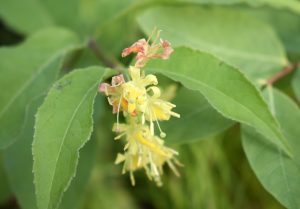Bush Honeysuckle
 Diervilla lonicera is a native, low growing shrubby perennial that is not a true honeysuckle (true honeysuckles have berries and smooth-edged leaves), but reasonably so named due to the flower resemblance. The plant reaches a height of 1 to 3 feet and up to 4 feet wide. Bush honeysuckle’s funnel-shaped yellow flowers first appear in mid to late June blooming into July beginning about the same time as the dogbanes bloom and while the flower clusters of nearby sumac shrubs and milkweed plants are forming but still tightly closed. As bush honeysuckle’s yellow flowers fade and age, they turn orange or even reddish. Leaves are oppositely attached, and taper to a pointed tip.
Diervilla lonicera is a native, low growing shrubby perennial that is not a true honeysuckle (true honeysuckles have berries and smooth-edged leaves), but reasonably so named due to the flower resemblance. The plant reaches a height of 1 to 3 feet and up to 4 feet wide. Bush honeysuckle’s funnel-shaped yellow flowers first appear in mid to late June blooming into July beginning about the same time as the dogbanes bloom and while the flower clusters of nearby sumac shrubs and milkweed plants are forming but still tightly closed. As bush honeysuckle’s yellow flowers fade and age, they turn orange or even reddish. Leaves are oppositely attached, and taper to a pointed tip.
Fruit is a 2-valved capsule about 1/3 to 1/2 inch long, protected by the persistent sepals (even after the petals wither) as the fruit forms and develops. Inside, tiny seeds form and then are released into the wind when they are ripe by the capsule splitting open. Autumn into winter, fruit capsules that remain on the plant are relished by hungry songbirds. Bush honeysuckle plants are self-sterile, needing pollinators to visit from a nearby plant that is not a clone.
Bush honeysuckle would make an attractive ground cover in a native landscape, for even though it suckers from its rhizomatous root system it is not considered invasive. In time, an attractive thicket forms. Suckers can also be transplanted to start new plants.
Bush honeysuckle is one of the few larval hosts for the fawn sphinx moth (Sphinx kalmiae).
